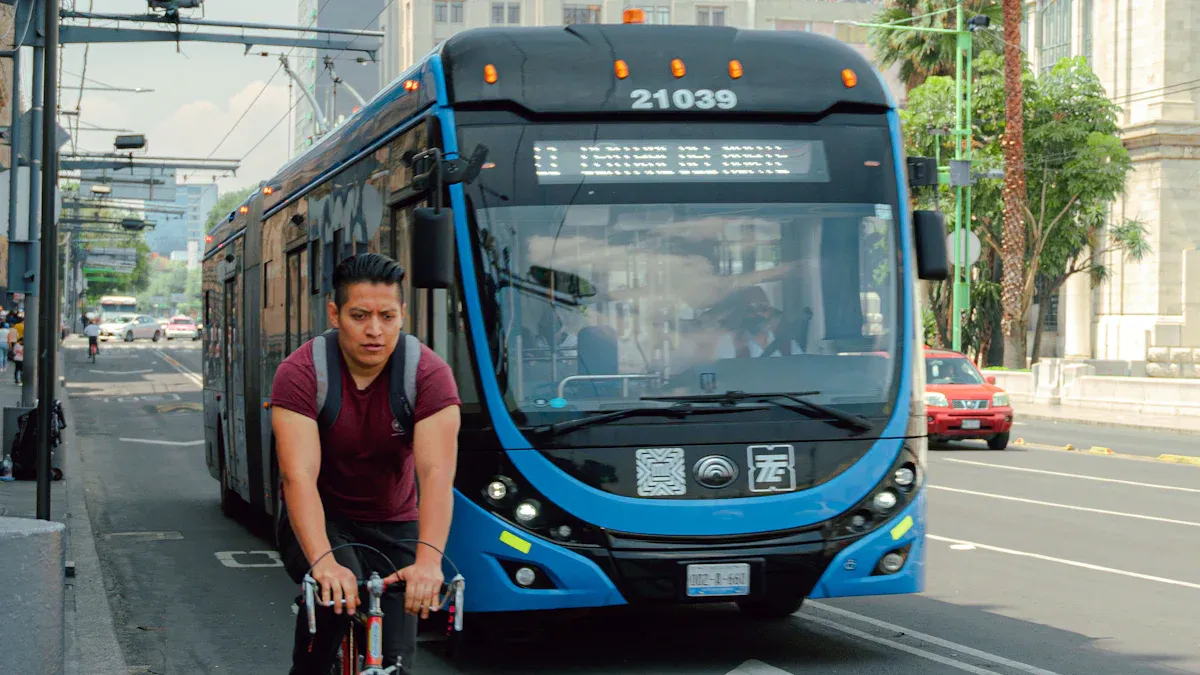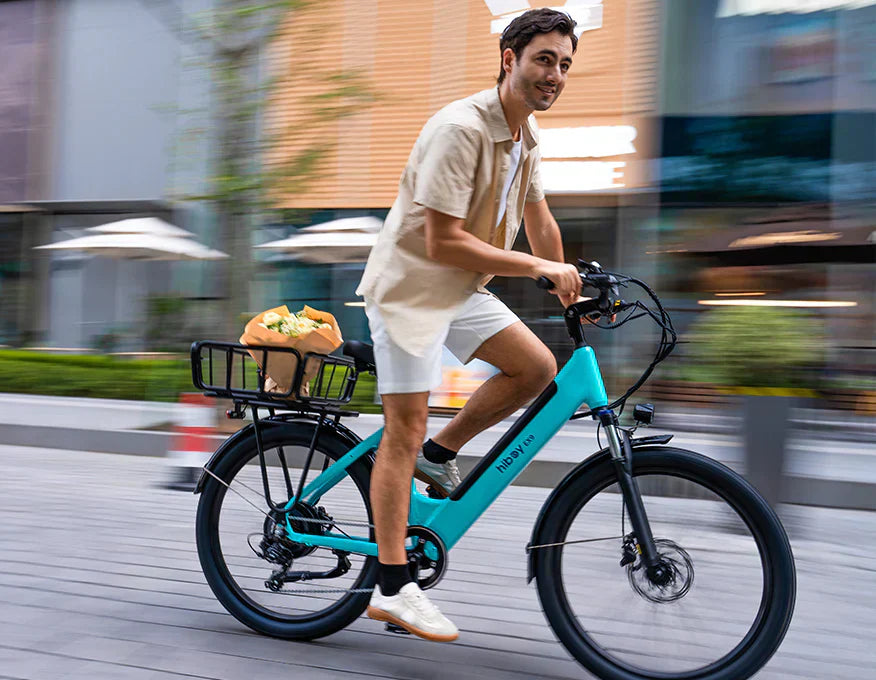You can often bring eBike on public transportation, but you must check your local transit rules first. Each transit agency sets its own policies due to concerns about fire risk from lithium batteries, limited space, and safety. Folding eBikes sometimes receive easier approval than non-folding models. Some transit systems restrict eBikes to prevent theft or because they cannot provide secure storage. To make your travel smoother, plan ahead and always review the latest transportation guidelines before you bring eBike on public transit.
Key Takeaways
-
Always check your local transit agency’s rules before bringing your eBike on public transportation to avoid surprises and ensure compliance.
-
Folding eBikes with removable batteries are usually easier to bring on buses, trains, and ferries because they fit better and meet safety standards.
-
Remove your eBike battery if required, power off your bike before boarding, and never bring damaged batteries to keep everyone safe.
-
Travel during off-peak hours and use designated bike racks or spaces to make your trip smoother and avoid blocking aisles or exits.
-
Combining your eBike with public transit saves money, reduces pollution, and gives you flexible, faster, and less stressful commutes.
Bring eBike: What to Know
General Allowance
You will find that the ability to bring ebike on public transit depends on where you live and which agency you use. In North America and Europe, transit systems treat e-bikes differently. In Europe, e-bikes are seen as everyday transportation tools. You will notice more supportive infrastructure and clear rules and regulations. In the United States, e-bikes often fall into the recreational vehicle category. This leads to higher power limits but less consistent infrastructure for bringing electric bikes onto transit.
-
In Europe, you see conservative power limits for e-bikes and strong cycling infrastructure.
-
In the US and Canada, cities are working to integrate e-bikes with public transportation to improve urban mobility.
-
Canadian cities invest in e-bike lanes and charging stations, and some offer incentives for e-bike adoption.
-
Many European countries provide rebates and incentives for e-bike users, making it easier to transport e-bikes on transit.
Tip: Always check your local transit agency’s website or ask staff about current rules before you bring ebike on a bus, train, or ferry.
Restrictions and Limits
Transit agencies set specific restrictions to keep everyone safe and comfortable. You must follow these rules and regulations when you bring ebike on public transportation. The most common limits involve the size, weight, and battery of your e-bike.
-
Folding e-bikes are usually allowed on transit more easily. You can fold them quickly and carry them like luggage.
-
Most folding e-bikes weigh between 30 and 50 pounds. Heavier standard or cargo e-bikes may not be allowed.
-
Some transit systems require you to remove the battery before boarding. This reduces weight and addresses battery safety concerns.
-
Many agencies only allow e-bikes during off-peak hours. You may not bring ebike on transit during rush hour.
-
Some systems require permits or restrict e-bikes to certain racks or areas.
-
Bus drivers or train operators can refuse e-bikes if space is limited.
Battery safety is a top concern for transit agencies. Lithium-ion batteries can overheat, catch fire, or explode if damaged or charged improperly. You should always use the charger that came with your e-bike and inspect the battery for cracks, leaks, or swelling. Never charge your e-bike near flammable materials or block exits on transit vehicles.
-
Agencies recommend regular battery checks and professional repairs for any damage.
-
You should disconnect the battery after charging and avoid overcharging.
-
Only bring e-bikes that meet legal safety standards, such as UL 2849 or CE marks.
Enforcement of these restrictions can vary. Most agencies rely on education and outreach to help riders follow the rules. Some shared e-bike services use software to limit speed, but traditional enforcement is difficult because bikes do not have license plates. Operators may use their judgment to decide if you can bring ebike on board.
Note: Folding e-bikes with removable batteries are the most compatible with public transit. They fit in small spaces and meet most safety requirements.
Public Transportation Policies
Check Transit Rules
You should always check local guidelines before you bring your e-bike on public transportation. Each transit agency sets its own rules. These rules can change often. You might find that what works in one city does not work in another. Some public transportation systems allow e-bikes only during certain hours. Others may ban them on crowded routes. You can find the latest guidelines on official transit websites. Many agencies also update their social media pages with new regulations.
Tip: Ask transit staff if you feel unsure about the rules. They can help you avoid mistakes.
Rules vary because cities and regions have different needs. Urban areas often create detailed regulations to keep riders safe and make public transit work for everyone. Suburban places sometimes set stricter rules, especially on trails, because they worry about fast e-bikes. Local priorities, terrain, and how people use bikes all shape these guidelines. The three-class e-bike system also affects where you can ride and what you can bring on transit.
If you break the rules, you may face fines or other penalties. For example, New York City enforces e-bike regulations with strict fines and even confiscation. Delivery riders risk losing their bikes if they do not follow the guidelines. Here is a table showing some possible penalties:
|
Violation Type |
Penalty for First Offense |
Penalty for Third and Subsequent Offenses (within 18 months) |
|---|---|---|
|
Riding on Hudson River Greenway |
Fine up to $150 and 15 days jail |
Fine up to $450 and 90 days jail |
|
Enforcement Action |
Description / Penalty |
|---|---|
|
Fines for e-bike operators |
Up to $500 per summons |
|
Confiscation |
Up to 923 e-bikes seized from delivery riders |
|
Civil summons to businesses |
$100 first offense, $200 for subsequent |
Find Signage and Info
You can find important information about e-bike rules posted at transit stations. Look for signs near entrances, on platforms, and inside vehicles. These signs tell you where you can bring your e-bike and what you must do. Some public transportation systems use symbols or pictures to make the rules easy to understand.
If you cannot find clear signs, ask a staff member or check the transit agency’s website. Many agencies also have customer service numbers. You can call and ask about current guidelines. This helps you avoid problems and keeps the public transportation system safe for everyone.
Note: Always follow posted guidelines and respect other public transit riders. This helps keep the public transportation system running smoothly.
E-Bike Rules by Transit Type
Buses
You can bring e-bikes on many public buses, but you must follow strict rules. Most bus systems only allow folding e-bikes. You need to fold your e-bike before boarding and store it so it does not block the aisle. Full-size e-bikes usually do not fit inside buses. Some buses have exterior racks, but these racks have size and weight limits.
Here is a table showing common limits for e-bikes on bus racks:
|
Parameter |
Limit Range |
|---|---|
|
Maximum Wheel Size |
|
|
Maximum Tire Width |
Up to 3 inches |
|
Maximum Wheelbase |
Up to 46 inches |
|
Maximum Weight |
55 pounds per bike |
If your e-bike is too heavy or large, the driver may not let you board. Always check if your e-bike fits these limits before you travel. Some racks can only hold two or three bikes at a time. If the rack is full, you must wait for the next bus.
Tip: Remove your e-bike battery before boarding if the transit agency requires it. This makes your e-bike lighter and safer for public transport.
You should never bring a damaged battery on a bus. Bus operators can refuse e-bikes if they see any safety risk. Always power off your e-bike before you get on.
Trains
Trains offer more space for e-bike transport, but you still need to follow important rules. Most commuter rail and subway systems allow e-bikes during off-peak hours. Folding e-bikes are easier to bring on trains and are often treated like luggage. Non-folding e-bikes may face more restrictions.
Here is a table comparing e-bike policies for trains and subways in major cities:
|
Transit Mode |
eBike Policy Highlights |
Restrictions and Recommendations |
|---|---|---|
|
Commuter Rail |
Bikes allowed off-peak; folding e-bikes permitted anytime |
Limited racks; check size/weight; avoid rush hours |
|
Subway |
Bikes allowed except during rush hours; folding bikes must be folded |
No riding in stations; avoid blocking aisles |
You must follow battery safety rules on trains. Many train systems require you to remove the battery from your e-bike before boarding. Some agencies ask you to pack the battery safely to prevent short circuits or damage. Train operators look for safety certifications like UL 2849 or UL 2271 on electric bike batteries. These certifications show that your battery meets fire and electrical safety standards.
-
Remove your battery if the rules say so.
-
Pack your battery to prevent damage.
-
Only use batteries with safety certifications.
-
Never bring a damaged or leaking battery.
Some train networks limit the number of e-bikes per car. If the train is crowded, you may need to wait for the next one. Always power off your e-bike before boarding and never charge it on the train.
Note: London and some other cities only allow folding e-bikes on trains because of past battery fires. Always check local rules before you travel.
Ferries
Ferries often allow e-bikes, but you must follow special rules for safety and space. Most ferries have designated parking areas for bikes. You need to secure your e-bike with a lock during the trip. Some ferries limit the number of e-bikes on board, especially during busy times.
|
Transit Mode |
eBike Policy Highlights |
Restrictions and Recommendations |
|---|---|---|
|
Ferries |
Bikes allowed with designated parking; lock required |
Avoid blocking walkways; check ferry-specific rules |
You should never block walkways or exits with your e-bike. Always power off your e-bike and remove the battery if the ferry operator asks. Some ferries have weight or size limits for bikes, so check before you travel.
Callout: Always use a strong lock to prevent theft during your ferry ride.
No matter which public transit you use, damaged batteries are never allowed. You must power off your e-bike before boarding. Respect other passengers and follow all posted rules for safe and smooth e-bike transport.
Transport Your eBike: Tips
Prepare Your eBike
Before you travel, get your ebike ready for public transportation. Remove any loose items, such as baskets, panniers, or water bottles. This prevents items from falling off or blocking other passengers. Check your ebike’s weight and size to make sure it fits the rules for your local transportation system. Fold your e-bike if possible, as this makes it easier to carry and store. Always confirm the latest guidelines with your transit authority by checking their website, calling customer service, or reading signs at stations.
-
Take off detachable parts like batteries and displays.
-
Keep your battery handy in case staff ask for details about its type or safety.
-
Use a foldable ebike for a hassle-free commute.
Tip: Plan ahead and pack only what you need. This helps you move quickly and safely when you board.
Timing and Space
Choose the right time to transport your ebike. Many transit systems restrict e-bikes during busy hours. Try to travel during off-peak times when there is more space. This makes it easier to find a spot for your ebike and reduces stress for everyone. Stand near the doors for quick boarding and exiting. If the vehicle is crowded, wait for the next one to avoid blocking aisles or seats.
-
Avoid peak hours to make transporting bicycles easier.
-
Look for designated bike areas or racks on buses, trains, or ferries.
Practical tips: Traveling at quieter times gives you more room and helps you follow transportation rules.
Secure and Handle
When you board, secure your ebike so it does not move or tip over. Use straps or locks provided by the transit system. If you bring your own lock, choose a strong one that can attach the frame and wheels to a solid part of the vehicle. Remove the battery and display to prevent theft or damage. Always park your e-bike in visible, high-traffic areas if possible.
-
Make sure your ebike does not block walkways or exits.
-
Be ready to lift your ebike if needed, especially on stairs or crowded vehicles.
Note: Respect other passengers and follow all posted rules. Good handling onboard logistics keeps everyone safe and comfortable.
By following these practical tips, you can transport your ebike smoothly and enjoy a hassle-free commute. Handling onboard logistics well helps you and others have a better experience when you transport e-bikes on public transportation.
Benefits of Combining eBike and Transit
Flexibility
When you combine your eBike with public transit, you unlock a new level of flexibility in your daily commute. Many people want more choices for how they get to work or school. About 78% of public transport users prefer to use personal micromobility or mix public transit with shared micromobility. This shows that most riders want options that fit their needs.
-
You can solve the "last-mile" problem by riding your eBike from the transit stop to your final destination.
-
E-bikes help you avoid traffic jams and parking problems, making your commute faster and less stressful.
-
Electric assistance lets you travel longer distances or tackle hills without getting tired.
-
Foldable e-bikes fit easily on buses, trains, or ferries, so you can switch between modes with ease.
Tip: Look for covered bike lanes and sheltered docking stations. These features protect you and your eBike from bad weather and make your commute smoother.
Studies show that e-bikes travel faster than regular bikes, with average speeds around 13.3 km/h. This means you can save time, especially when you need to connect different parts of your commute. Urban planners see integrating ebikes with public transit as a smart way to improve travel time and convenience for everyone.
Cost and Environment
Choosing to commute with an eBike and public transit can save you a lot of money. Over five years, you could save between $46,000 and $79,000 compared to owning a car. These savings come from lower costs for buying, fueling, and maintaining your eBike. You also avoid paying for parking and expensive insurance. Many cities offer tax credits and rebates, making this option even more affordable.
|
Expense Category |
Car Ownership (5 Years) |
eBike + Transit (5 Years) |
Savings |
|---|---|---|---|
|
Purchase & Financing |
High |
Low |
✔ |
|
Fuel/Electricity |
High |
Very Low |
✔ |
|
Insurance |
High |
Minimal |
✔ |
|
Maintenance |
High |
Low |
✔ |
|
Parking |
High |
None/Low |
✔ |
You also help the environment by reducing carbon emissions. If you shift just 25% of short car trips to e-bikes in big cities, you could save over 1.8 million metric tons of CO2 each year. This is like avoiding the use of 208.5 million gallons of gasoline. Nearly half of shared e-bike trips replace car rides, which means you play a big part in promoting sustainability and protecting the environment.
Note: The benefits of transporting your ebike go beyond saving money. You support cleaner air and a healthier city every time you choose this way to commute.
To bring your ebike on public transit, follow these steps:
-
Check local public transit policies and confirm ebike restrictions before you travel.
-
Prepare your ebike by removing loose items and batteries if needed.
-
Use designated racks or spaces and secure your ebike properly.
Planning ahead helps you enjoy the flexibility of combining your ebike with public transportation. You support a smoother commute and help create a more connected city.
FAQ
Can you bring any type of eBike on public transit?
You cannot bring every eBike. Most agencies allow only folding eBikes or those that meet size and weight limits. Always check your transit system’s rules before you travel.
Do you need to remove the battery from your eBike?
Some transit agencies require you to remove the battery before boarding. This helps prevent safety risks. Always check the rules for your city. If you must remove it, keep the battery with you.
What should you do if the bus or train is crowded?
Wait for the next vehicle if you see no space for your eBike. Never block aisles or exits. Respect other passengers and follow all posted rules.
Are there extra fees for bringing an eBike on public transit?
Most transit systems do not charge extra for eBikes that meet their requirements. Some may require a permit or ticket for larger bikes. Always check the fare policy before your trip.
What happens if your eBike does not fit on the rack or in the designated area?
-
You cannot board with your eBike if it does not fit.
-
The driver or operator may ask you to wait for the next vehicle.
-
Always measure your eBike before your trip to avoid problems.











Partager:
When To Replace Ebike Brake Pads
Why You Should Consider a Fat Tire Ebike Compared to Regular Tire Electric Bikes